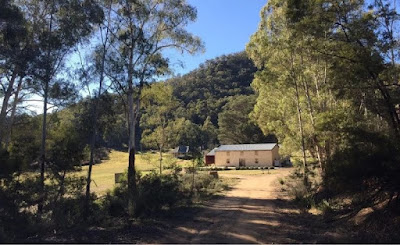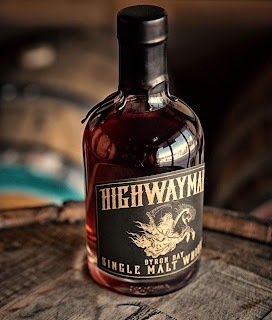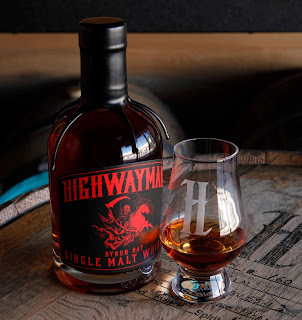Two recent cask strength releases from Ardnamurchan Distillery! The unpeated 'Paul Lanois' second release AD/06.22, and the peated Cask Strength first release AD/02.22. I could've stretched these out to two separate reviews, but they were begging for a head-to-head comparison!
Ardnamurchan is the latest venture from Adelphi, the privately owned and highly regarded independent bottler. When I say "latest venture" though, the distillery is more than 8-years old, having officially opened in July 2014. That makes it middle-aged compared to the swathe of new Scotch whisky distilleries that have popped up in the last five years or so. There were a few "work in progress" releases of Ardnamurchan spirit during the early years, including some single cask bottlings and annual larger batches from 2016-2019, while the first official Ardnamurchan whisky, romantically titled AD/09.20:1, was released in September 2020. That wasn't as young as you might expect, it was actually a 5-year old with some 6-year old whisky included in the vatting, meaning that Ardnamurchan/Adelphi were happy to wait until their whisky was ready rather than pushing it out the door on its third birthday. That first official whisky release was a mix of both peated & unpeated spirit, aged in 65% ex-bourbon casks and 35% ex-sherry casks, and was bottled at 46.8% ABV. The distillery bucked the first release hype trend since it was a large batch of nearly 16,000 bottles, and with reasonable pricing at $110 AUD in Australia, or just 45 GBP in Britain. It was a very impressive whisky, showing what this distillery's characterful spirit can offer at a relatively young ages and setting the bar quite high for the future. These core range releases continued with five more small batch releases since, all a mix of both unpeated & peated spirit and bottled at 46.8%. There have also been a few single cask releases for various markets, and more recently a few larger cask strength special releases including two unpeated 'Paul Lanois' batches, two small batch Cask Strength bottlings, and now a Madeira Cask finish, which hasn't made it to Australia yet (fingers crossed for that one!).
The distillery is located on the Ardnamurchan Peninsula on the west coast of the Scottish mainland. It may not look it on a map, but this is a very remote distillery, requiring a 4-hour drive north-west of Glasgow or 1.5-hours south-west of Fort William, the nearest major town and the nearest decent supermarket. Both options involve a long & arduous stretch of single-track road (which means my wife will refuse to drive there). While I'm sure you'd be comforted by some stunning scenery while waiting for oncoming traffic, I'd consider staying at Oban and then taking the ferry across to Mull - stopping at Tobermory, naturally - and then another up to Ardnamurchan. Partly due to its remote location, all of the distillery's power (by hydro-electric generator) and heat (by biomass boiler fuelled with local woodchip) requirements are supplied in-house. A portion of Ardnamurchan's barley requirements are grown in in Fife on the east coast, and while there are plans to install a floor maltings at the distillery, for the moment that Fife-grown barley is malted at Bairds and is combined with their commercial malt before being transported to the distillery. There are three dunnage warehouses on site, although unusually one of them has two stories with casks stacked three-high on both floors, and bottling takes place at Adelphi's plant over in Fife. Ardnamurchan is a Highland distillery, and a very coastal one at that, so capturing - or at least encouraging - that location in the spirit was always the plan. Production was largely designed by the late Dr. Jim Swan, using his preferred method of long fermentation (72-110 hours), slow distillation, and relatively narrow spirit cuts. There are a few minor departures from his typical distillery blueprint though; production is split 50/50 between peated (30 ppm using mainland peat) and unpeated and employs two different distiller's yeasts, they make a cloudier wort in search of a slightly heavier, oilier spirit, and there are no STR casks in the warehouses. The idea here was to make a slightly heavier spirit allowing for longer, slightly slower maturation, which can be seen in the ages of their bottlings so far, and to stick to more traditional cask types. Naturally, as you'd expect from Adelphi all Ardnamurchan whisky is non-chill filtered, naturally coloured and bottled at 46% or above.
The two bottlings that I'm looking at here are the second of the unpeated 'Paul Lanois' releases, officially titled AD/06.22, and the first of the peated Cask Strength releases, officially dubbed AD/02.22. That coding system is simply the month and year that the release was bottled, and if there's a third number, e.g. AD/04.21:03, that's a standard batch / core range bottling. We'll look at the unpeated Paul Lanois first, and we'll start with the obvious question: who is Paul Lanois, and why has Ardnamurchan named a whisky after him? Well Paul Lanois is a French champagne producer, and the two releases so far have been finished in ex-Paul Lanois wine casks - technically not champagne casks, because champagne is legally required to undergo a secondary fermentation in bottle. So the wine from these casks technically wasn't yet champagne, but it did become champagne after bottling. This is the second Paul Lanois release (the first was AD/04.21 and was 57.6% ABV), taken from casks of unpeated spirit that were distilled in 2015 and bottled in June 2022 at a cask strength of 57.5% ABV. Initial maturation was in ex-bourbon barrels, followed by an unspecified finishing period in the Paul Lanois wine casks. This was a relatively small release of 2,661 bottles, around 100 more than in the first release. This second Paul Lanois batch hasn't made it to Australia yet, and the sample for this review came from a generous fellow whisky nerd who didn't want to wait! Tasting time!
Ardnamurchan Paul Lanois Second Release, AD/06.22, 57.5%. Highlands, Scotland.
Colour: Bright gold.
Nose: Fruity, malty & sweet. Vanilla marshmallows, touch of cotton candy / fairy floss, rich toffee fudge, and golden malted barley. Soft sweet oak, pinch of sea salt, white chocolate. Tropical fruit underneath: roasted pineapple, dried mango, sweet white grape.
Texture: Medium-heavy weight. Oily, malty, rich. Touch of heat but very bearable.
Taste: Less sweet than the nose suggested. The maltiness is amplified here and has turned drier and biscuit-y. Clean vegetable oil, dried tropical fruit, and that vanilla marshmallow again. Chilli salt with a higher proportion of chilli, and a little burnt popcorn.
Finish: Medium-long length. Big oily, biscuit-y maltiness carries through, with the burnt popcorn and vanilla marshmallow following behind. Becoming more fruity & lightly acidic now, with more guava, pineapple (not roasted this time), white grape. A couple of walnuts, and toffee fudge.
Score: 3.5 out of 5.
Notes: This is my first go at an unpeated Ardnamurchan, but as you'd expect there are still some parallels with the peated spirit. That rich oily profile, the heavier weight and the coastal influence is all there, although the latter is obviously more subtle than it is in the peated stuff. This is a very malty whisky, in a drier, more biscuit-y way, and that oiliness does help to obscure both the youth and the ABV slightly. I haven't tried a straight ex-bourbon cask unpeated Ardnamurchan yet for comparison's sake (has anyone?), but the wine influence in this Paul Lanois release does seem very restrained - which is a good thing. I can see the tropical fruit notes coming from the wine casks or at least being amplified by them, but the balance here is impressive, particularly compared to some red wine finished or matured whiskies from other newish distilleries. That's the advantage of white wine casks, they're far more gentle, leaving more of the distillery character intact, and I hope we see more of them!
With that, on to the peated AD/02.22 Cask Strength release. This was the first cask strength batch and the only one to have made it to Australia so far (the second batch has been released in Britain, coded AD/09.22). AD/02.22 was taken from 50 casks, 10 casks of unpeated spirit and 40 of peated spirit, all distilled in 2014 and 2015 and bottled in early 2022, making it a minimum of 6-years old. 5 of these casks were first-fill sherry hogsheads and the rest were first-fill ex-bourbon barrels, primarily from Woodford Reserve. This detailed information can be gleaned by scanning the QR code on the back label, which tells you just about everything you could want to know! There were 12,886 bottles in the batch - so not particularly limited, which is a good thing considering how highly anticipated this bottling was - bottled at a cask strength of 58.7% ABV. Pricing was around $160 AUD locally, which is quite reasonable in this day & age. Tasting time!
Ardnamurchan Cask Strength AD/02.22, NAS, 58.7%. Highlands, Scotland.
Distilled in 2014 & 2015, vatting of 50 casks; 10 unpeated & 40 peated, 5 ex-sherry and 45 ex-bourbon. Non-chill filtered, natural colour. 12,886 bottles.
Colour: Pale gold.
Nose: Malty, coastal, oily. Olive brine, black peppercorns & dried (mild) green chillies. Touch of honey-roasted almonds, and blowtorched herbs - sage & rosemary. Wafts of gentle wood smoke & lemon juice as it breathes.
Texture: Medium-heavy weight. Salty, lightly peaty & smoky, malty. No heat at all.
Taste: Sharp lemon, and a lovely fizzy / effervescent peatiness, clean & earthy. Rock salt with freshly-emptied oyster shells. Green olives, yeasty sourdough starter, touches of roasted pineapple and vanilla bubble gum (if that exists!).
Finish: Medium-long length. More sharp lemon citrus, soft earthy peat smoke, clean & gentle. Vanilla bubble gum, green olives, touch of savoury honey and sea salt. Sounds like a weird combination, but it works! More of that oyster shell minerality and wafting soft wood smoke underneath.
Score: 3.5 out of 5.
Notes: Great stuff for its age, and solid value for money too. There's plenty of flavour and a good dose of oily & coastal spirit / distillery character - that seems to be the Ardnamurchan M.O., and it's great to see it in these releases. This heavier, oilier spirit is going to be tough to beat in the coming years! It's big, it's complex, and it's coastal, and it's tasty. And this is just 6-years of age! I'd give the peated AD/02.22 the win between these two releases, but there's really no great distance between them in terms of quality. While it's not a fair comparison, the difference in maturity between this and the first official / core range release is immediately obvious, and there's only a year between them if you go by the minimum ages. There are shades of other coastal whiskies here, Talisker in particular, but it's quite unique with that heavier spirit-driven oiliness that is sadly missing from many distilleries these days. Very impressive.
Cheers!
























